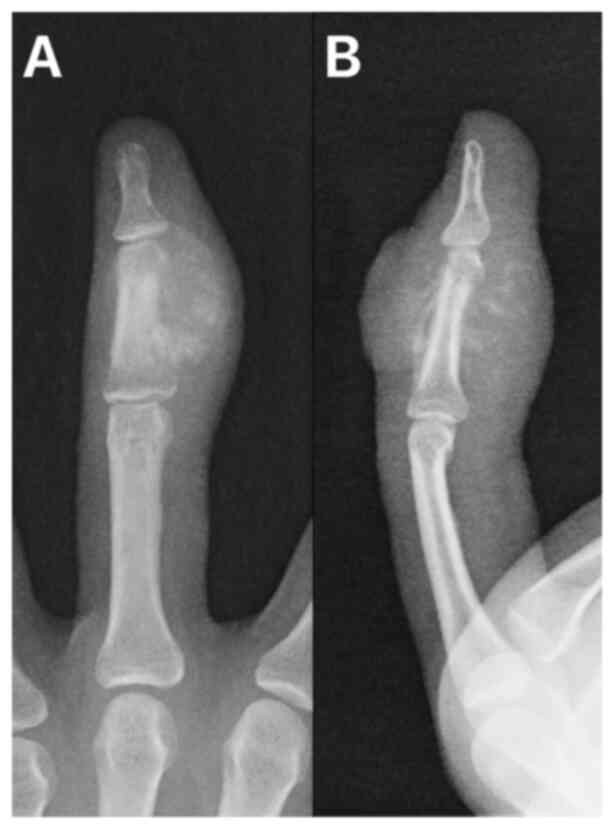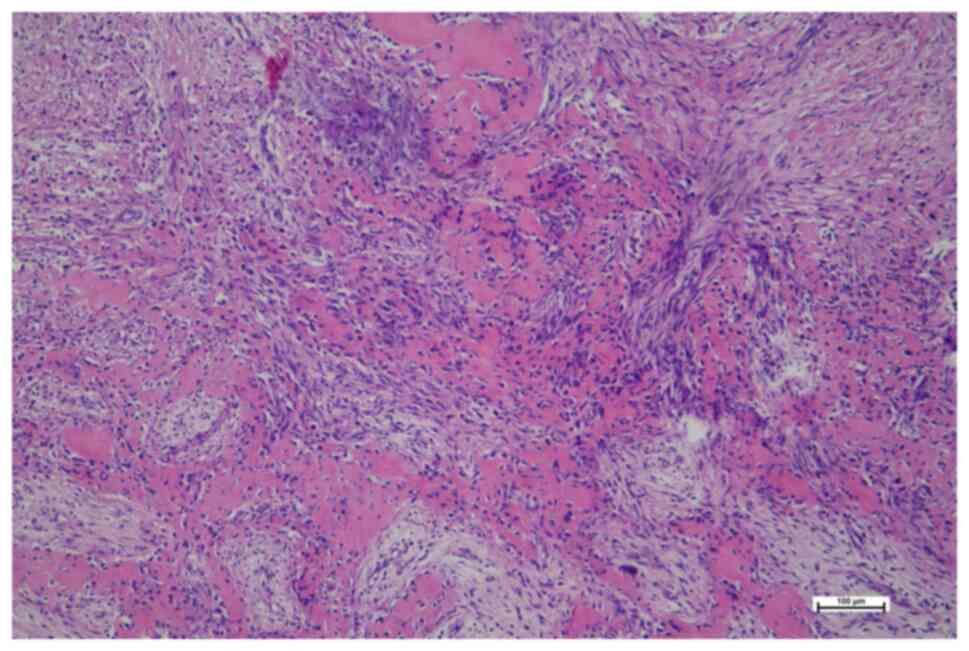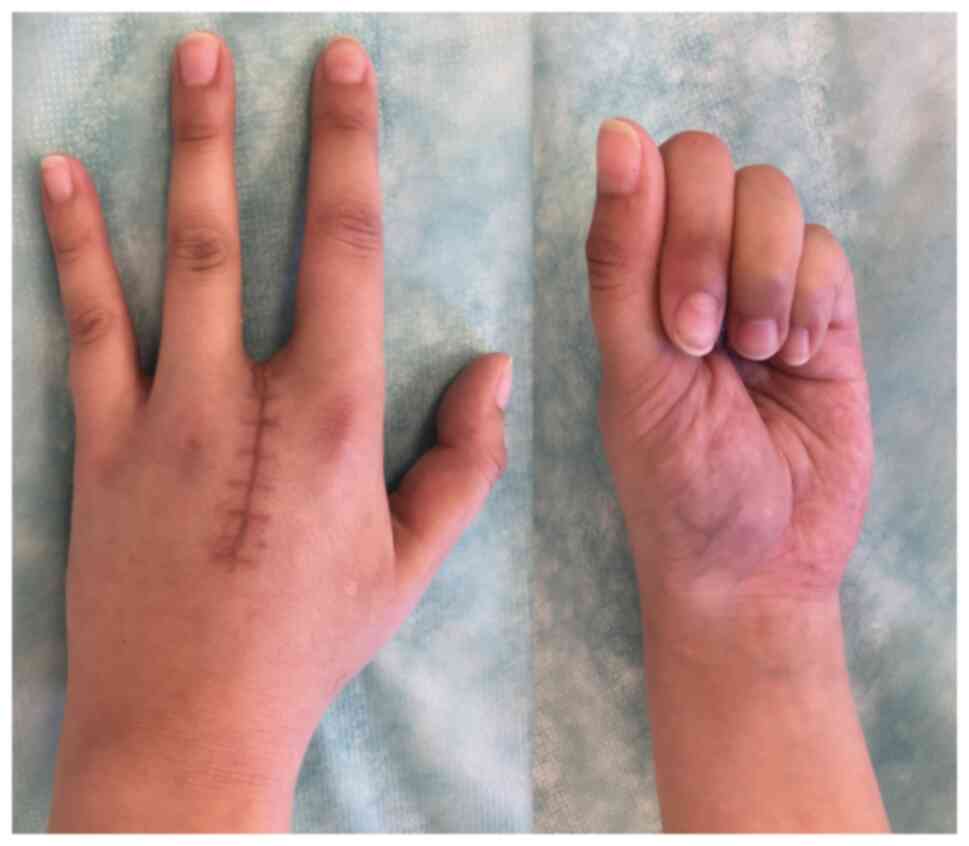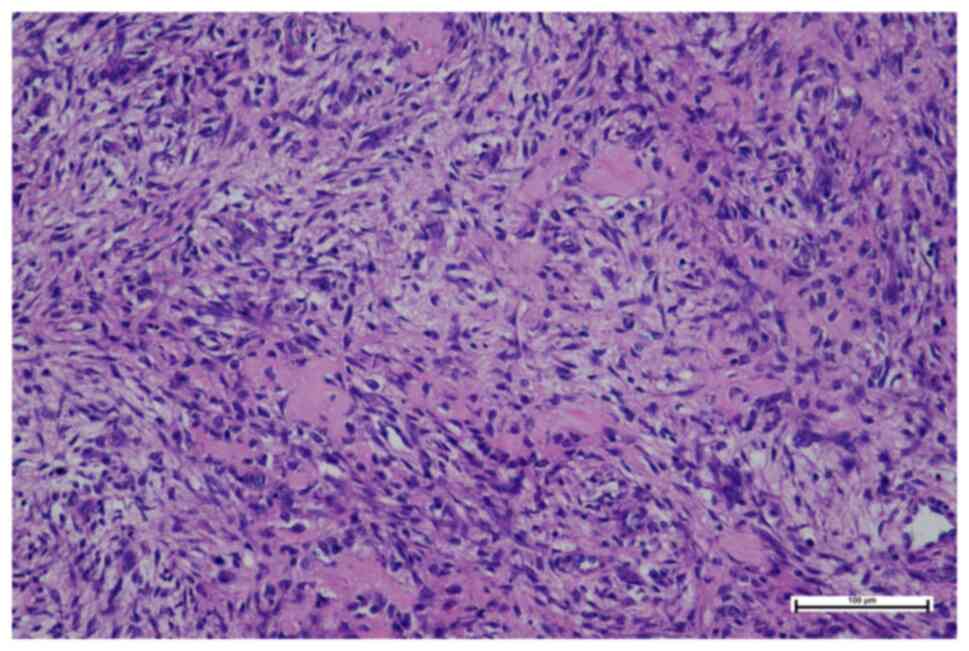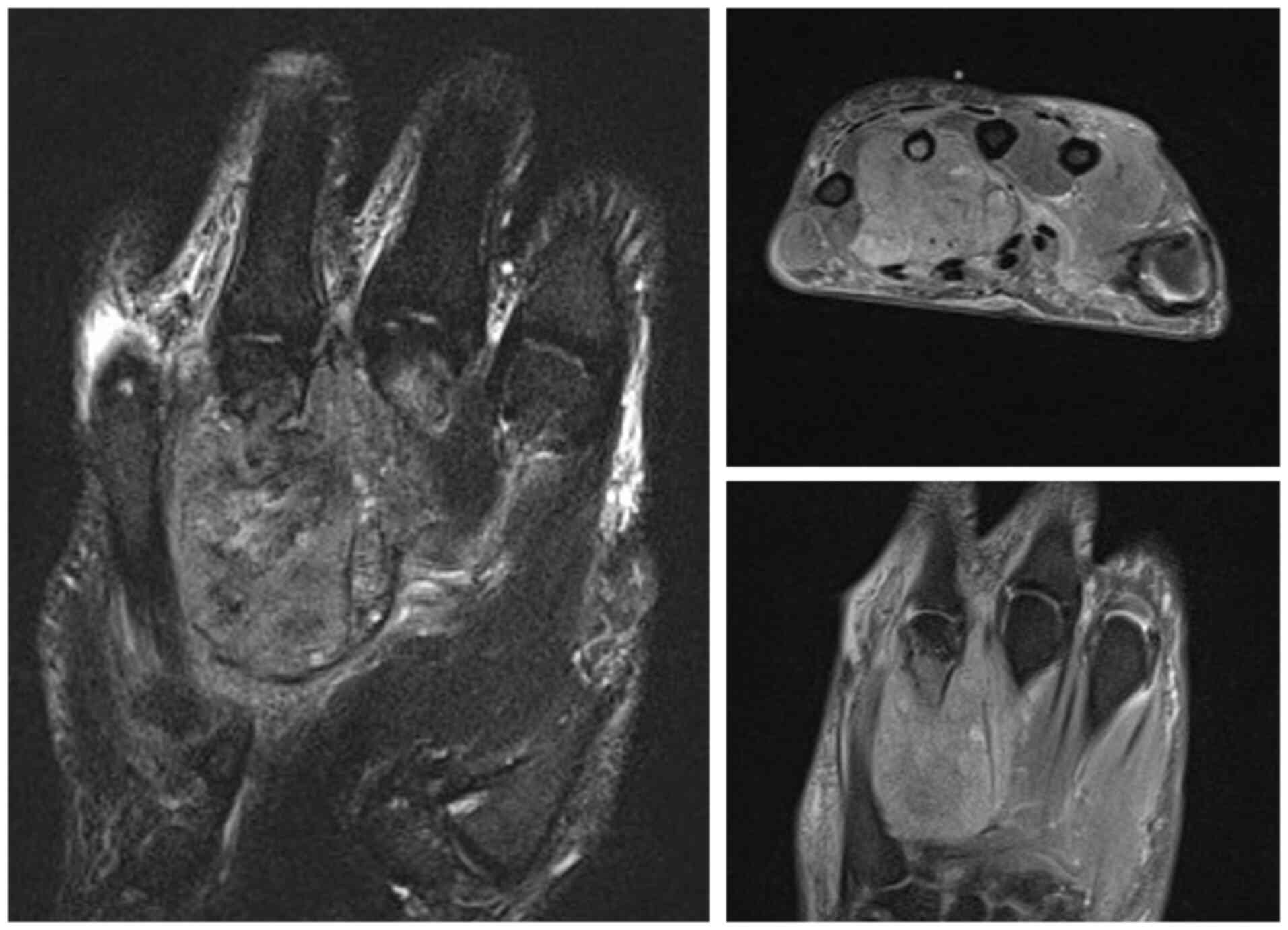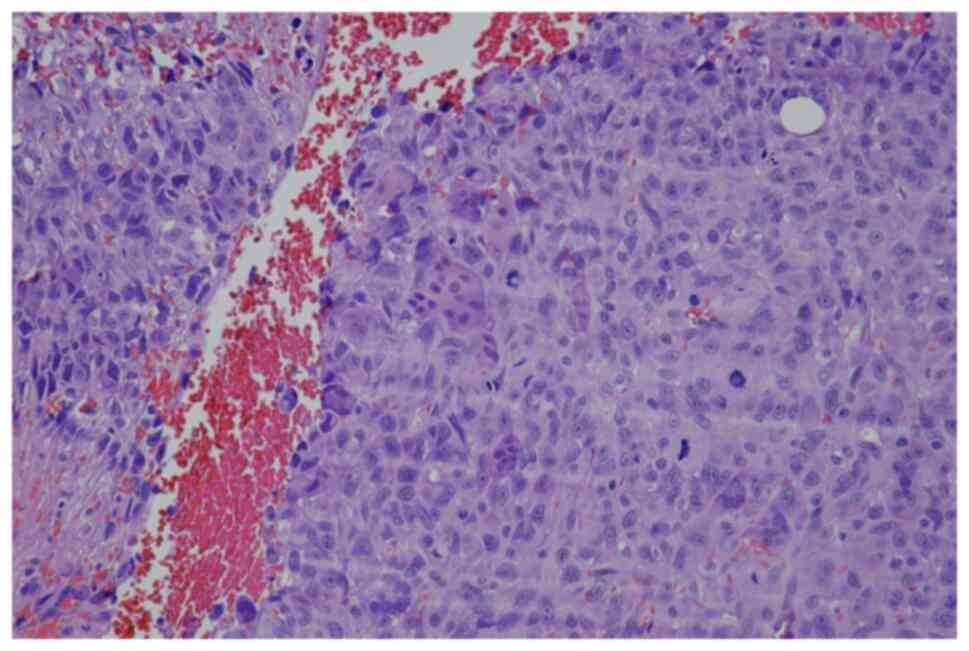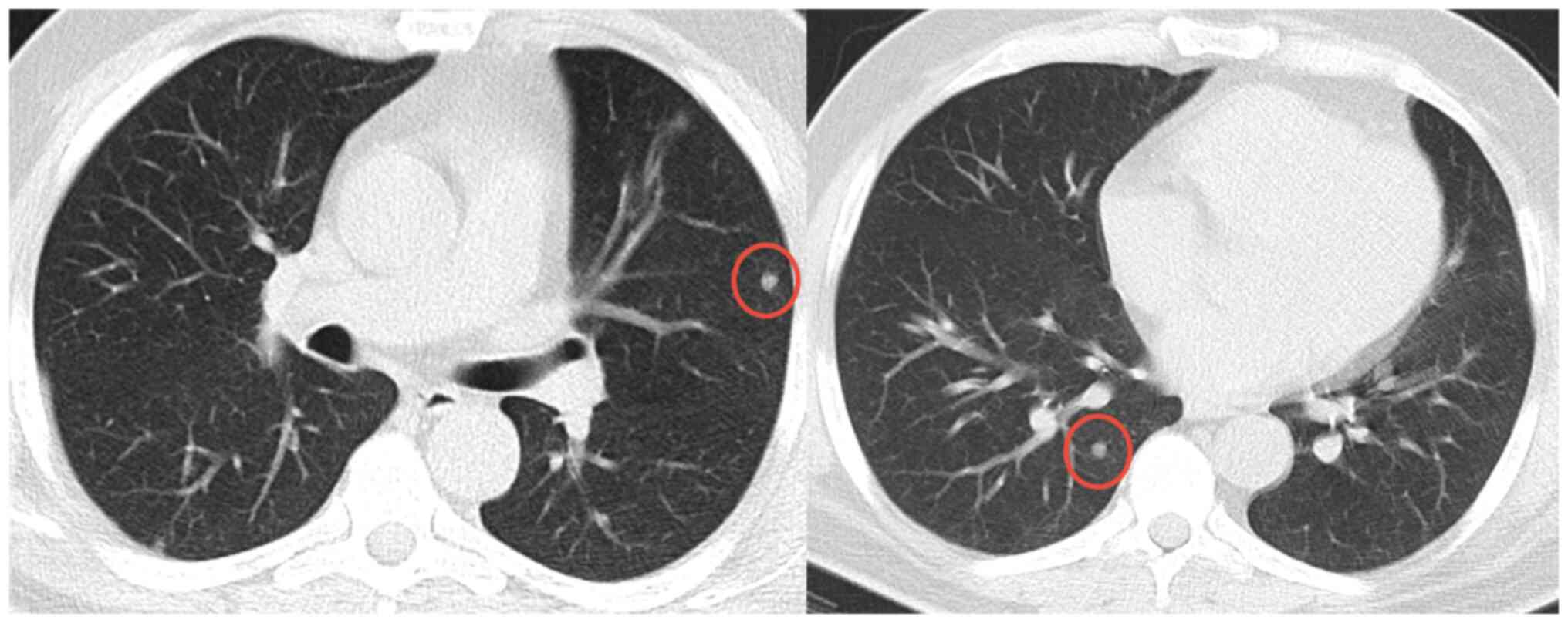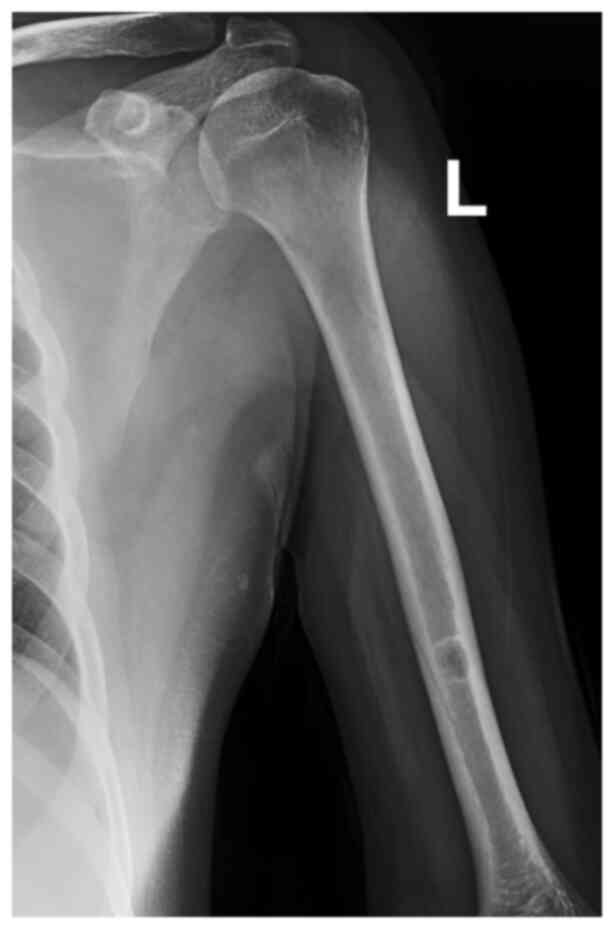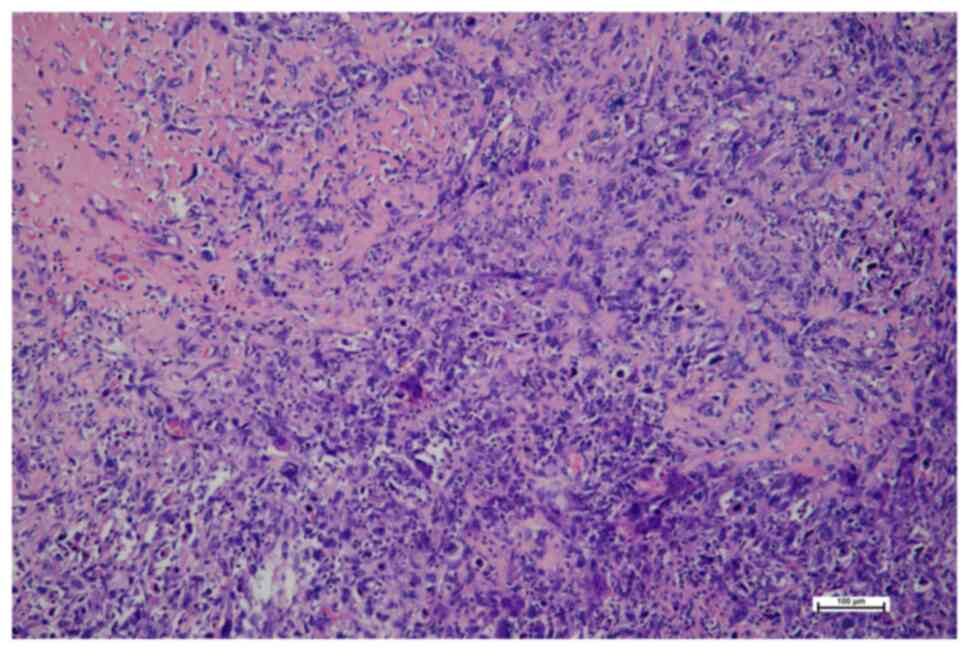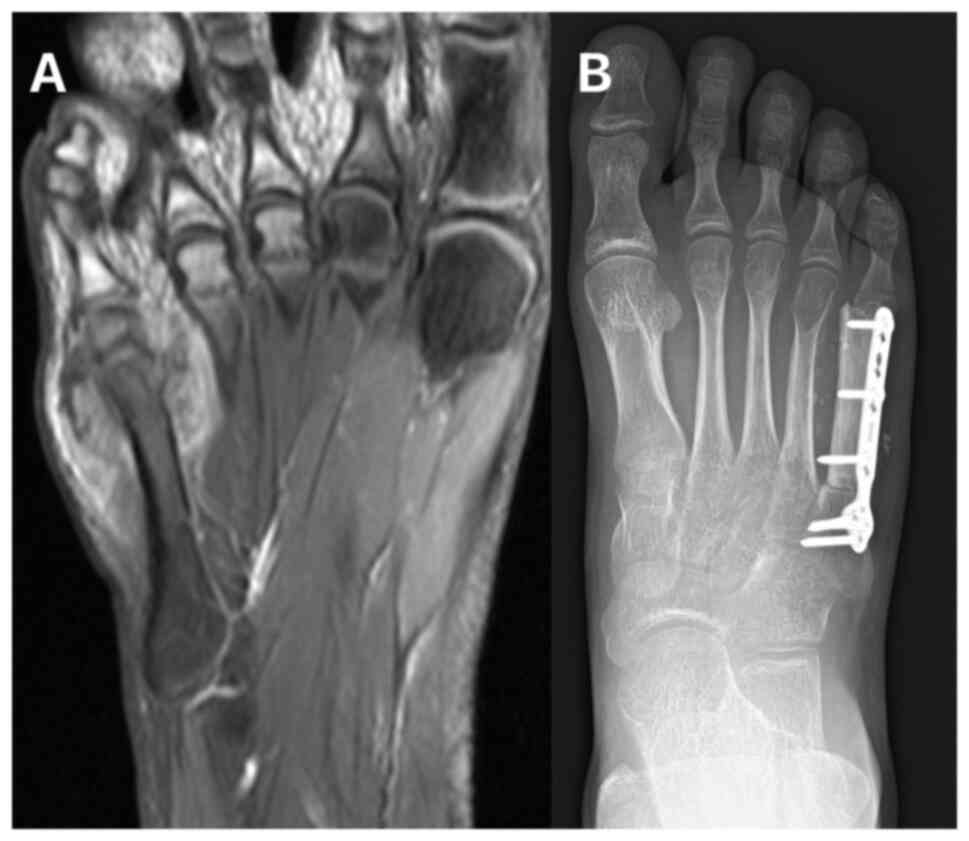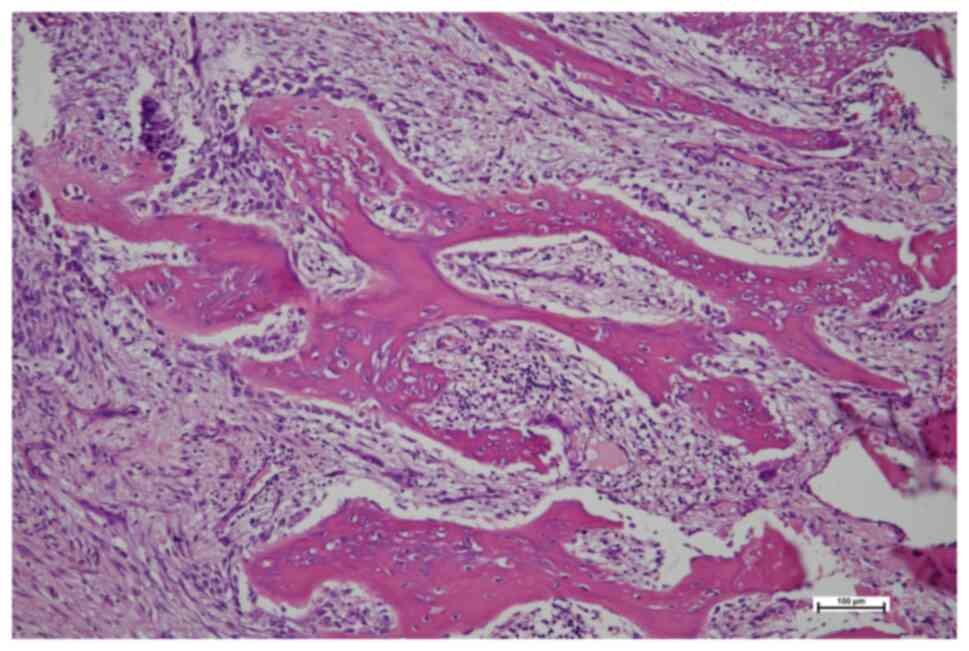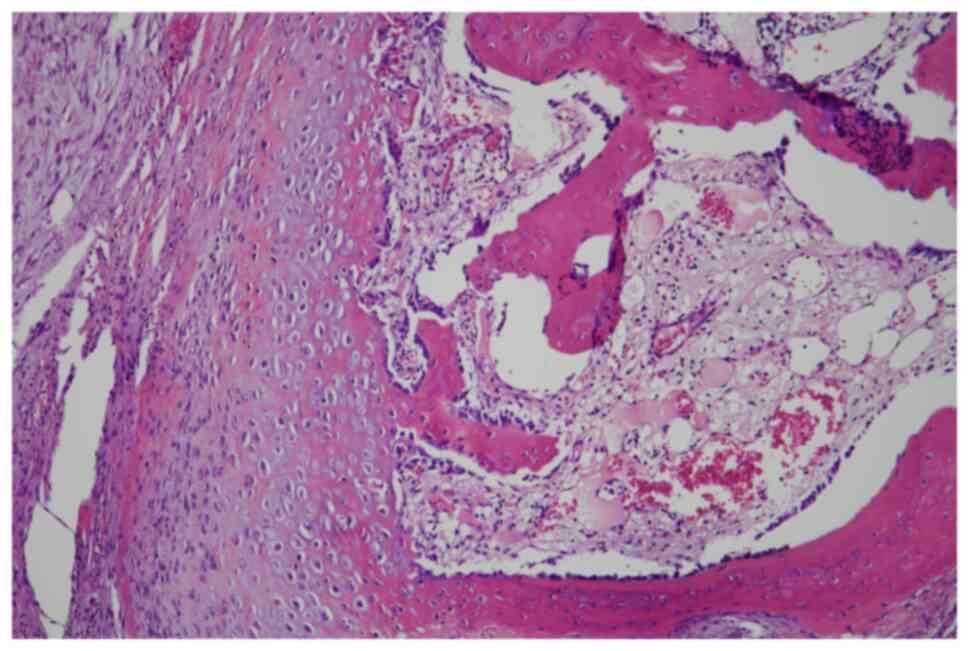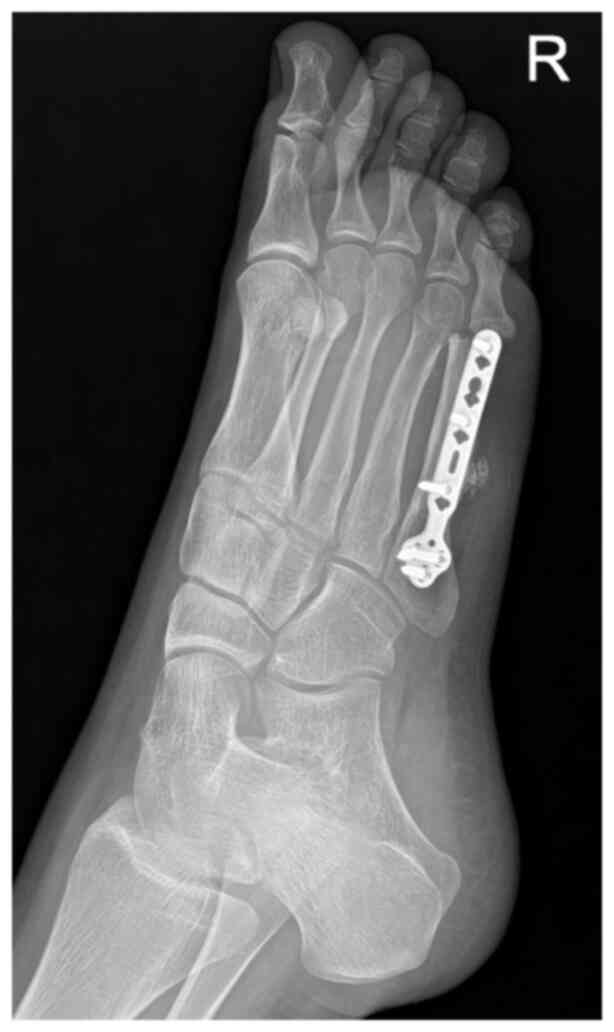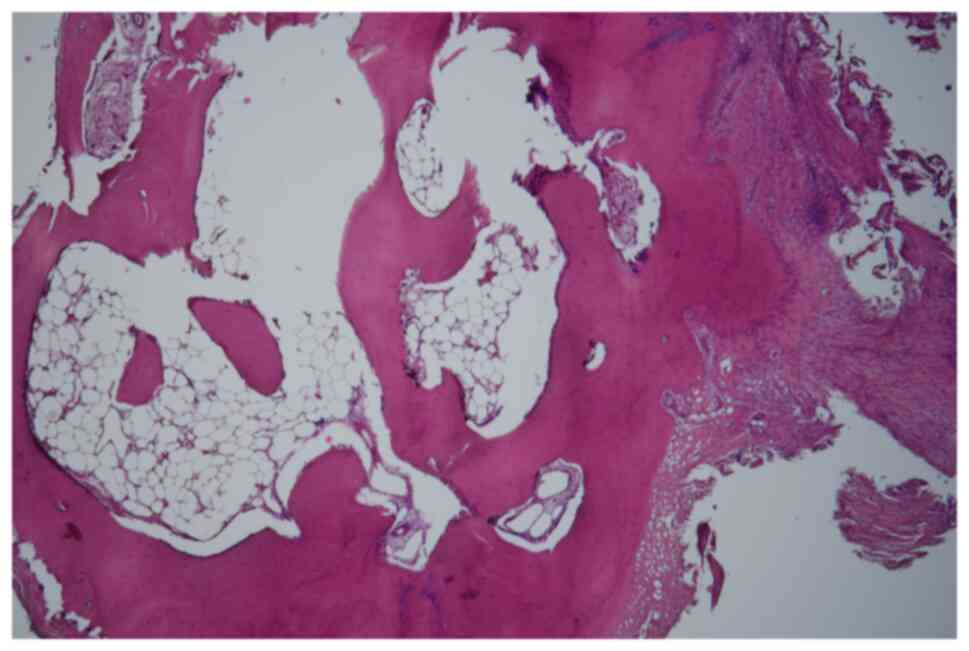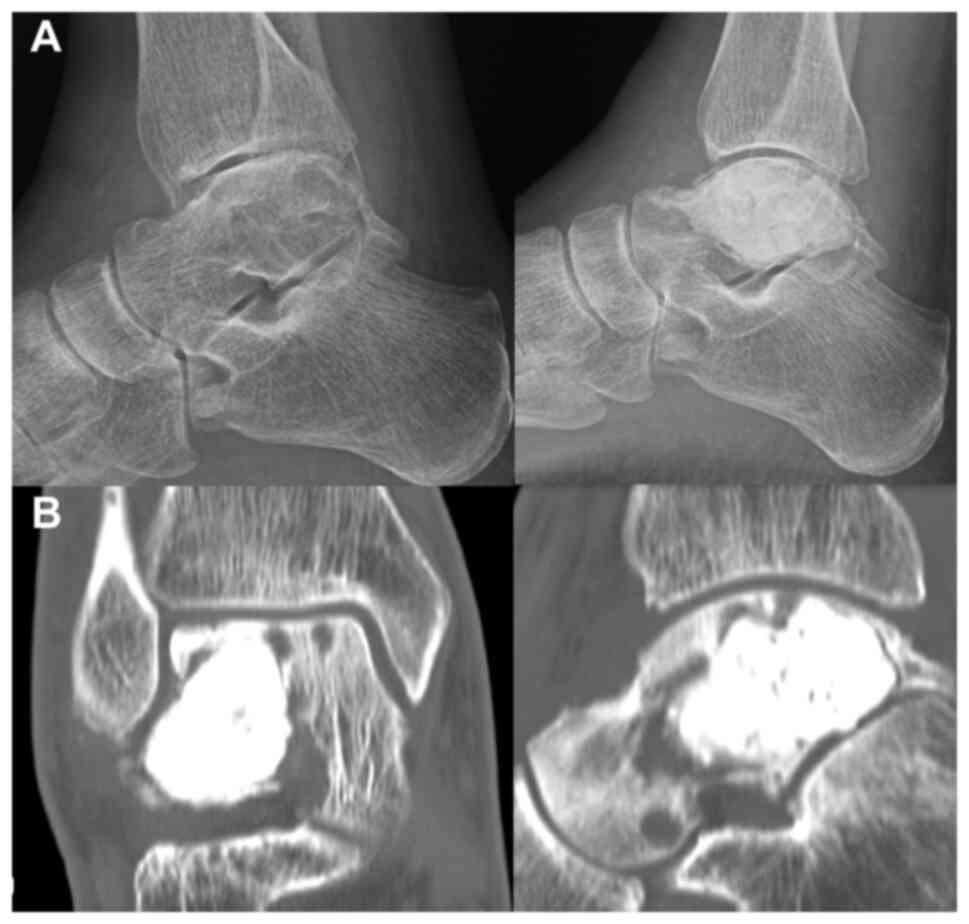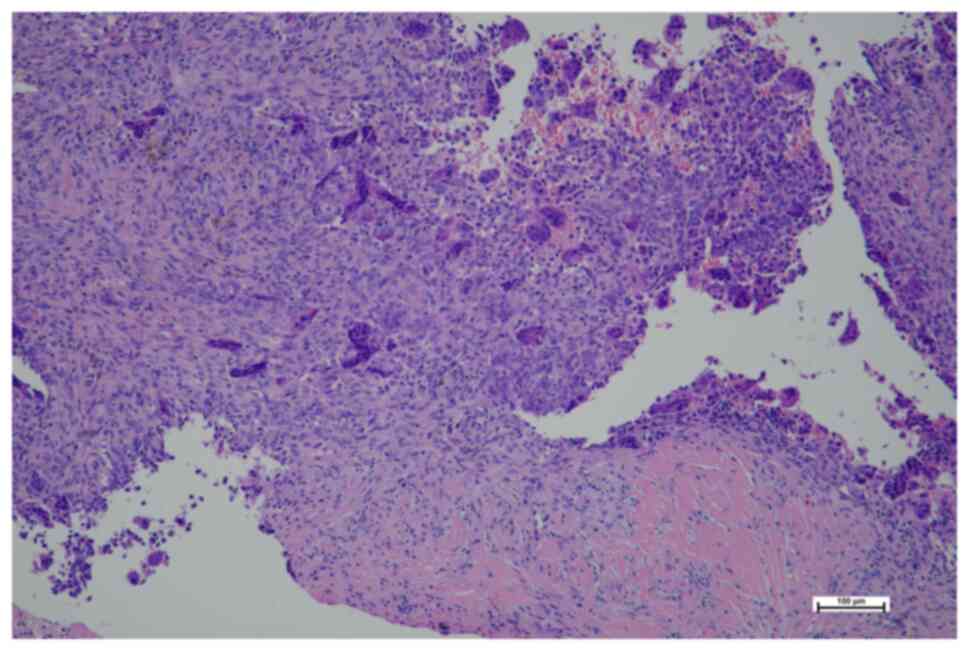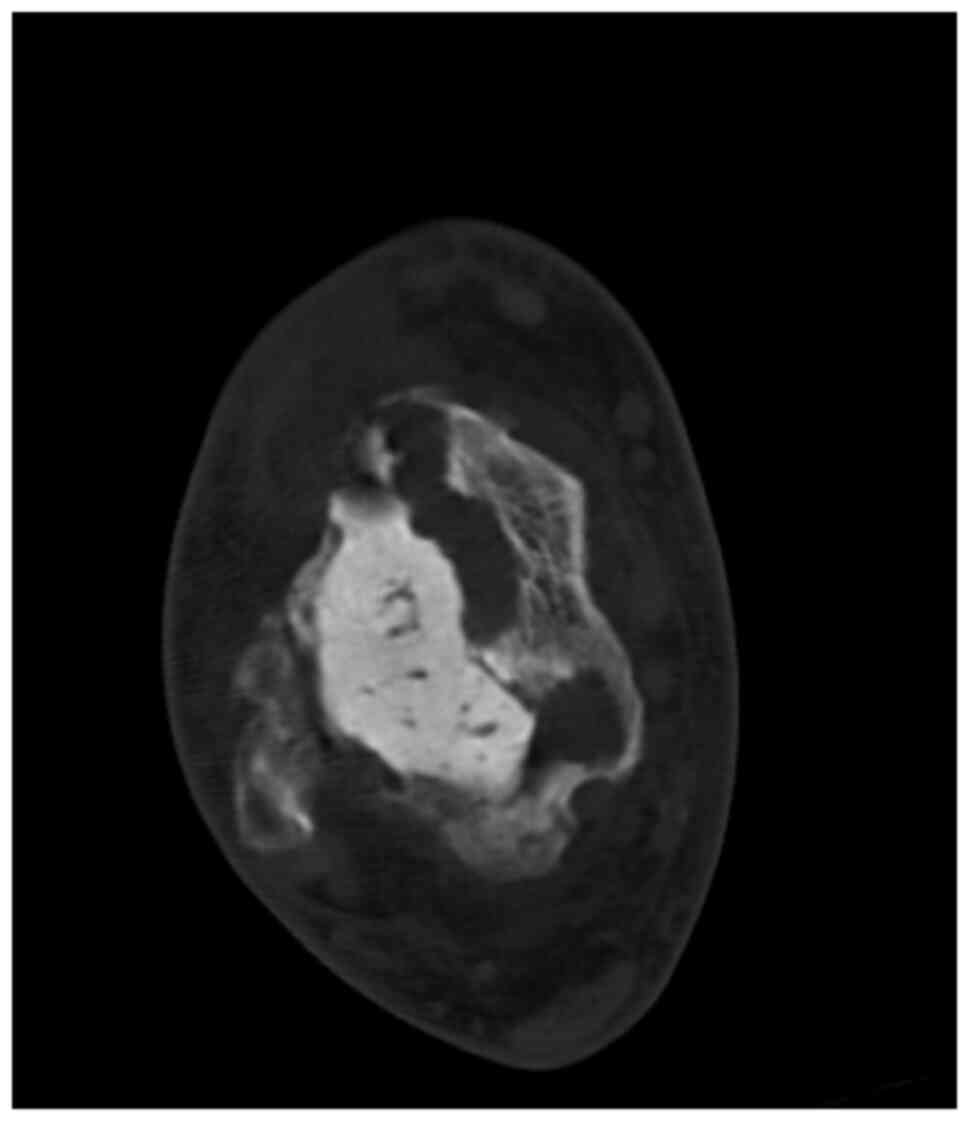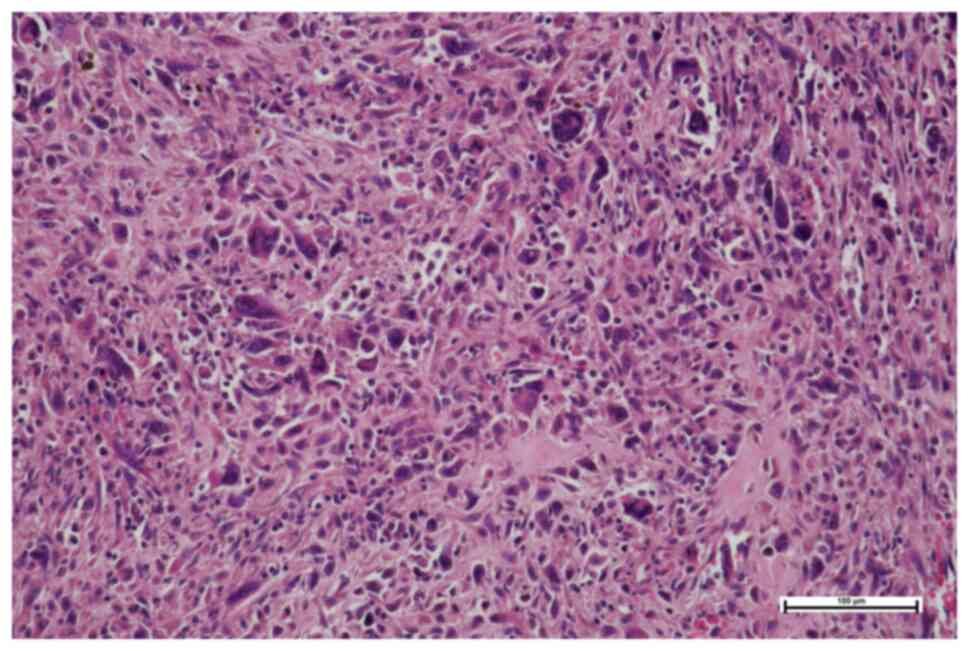Osteosarcomas of the hand and foot: A sarcoma‑center case series experience
- Authors:
- Published online on: November 12, 2024 https://doi.org/10.3892/ol.2024.14800
- Article Number: 54
-
Copyright: © Mahdal et al. This is an open access article distributed under the terms of Creative Commons Attribution License.
Abstract
Introduction
Osteosarcoma is a mesenchymal tumor of the bones, typically occurring in the long bones of the extremities. Osteosarcoma in the long bones of the extremities accounts for ~80–90% of all cases of osteosarcoma (1). By contrast, two of the rarest sites for this disease to be diagnosed are the hand and the foot, representing ~1% of all diagnosed osteosarcomas (2–4). The rarity of osteosarcoma of the hand and foot has led to frequent misdiagnosis, delayed diagnosis or inappropriate treatment of patients, which can have fatal consequences (5). The uncommon occurrence of osteosarcoma of the hand and foot, its similar appearance to benign lesions and the general lack of awareness of this disease may result in physicians not immediately suspecting osteosarcoma when evaluating patients. Delays in diagnosing and treating peripheral osteosarcoma can have a negative impact on patient outcomes. These delays may reduce treatment options and diminish the possibility of limb-sparing procedures, potentially affecting the overall prognosis and quality of life of patients. Previous studies have raised contradictions about the prognosis and treatment of hand and foot osteosarcoma when compared with that at other common sites (6). This condition primarily affects adolescents and young adults, with the majority of cases occurring between the ages of 10 and 25. However, it can also affect older adults (7). Outcomes for this disease typically have a favorable prognosis, but there are currently few reports on hand and foot osteosarcoma (8). In the hand and foot, salvaging the limb is typically the treatment of choice, and with the use of chemotherapy (CHT), 60–65% of patients with osteosarcoma can be cured without amputation (1,9).
Currently, there is a lack of comprehensive understanding and published data regarding the diagnosis, treatment and outcomes of osteosarcoma in the hand and foot, as these cases represent ~1% of all osteosarcomas. Due to its rarity, misdiagnosis and treatment delays are common, yet detailed reviews and analyses of such cases are limited. To build upon the limited existing literature, the present study conducted a series of single-center case reports on a group of patients treated at the Masaryk Memorial Cancer Institute Sarcoma Center (Brno, Czechia). The present retrospective cohort study aimed to review and analyze cases of osteosarcoma located in the hand and foot. Furthermore, certain patient cases were described to highlight key educational points, including unexpected outcomes, misdiagnoses and failed interventions. These case reports may offer valuable insights into treatment efficacy, diagnostic challenges and rare complications of hand and foot osteosarcoma. By identifying common misdiagnoses and raising awareness of the rarity of hand and foot osteosarcoma, the present study may contribute to more accurate and timely diagnoses, preventing delays in treatment.
Materials and methods
Study design and patient selection
The present retrospective study selected data from patients diagnosed with osteosarcoma of the hand and foot. Between January 2007 and January 2019, 11 patients were treated at the Masaryk Memorial Cancer Institute Sarcoma Center, with 5 cases involving the hand and 6 involving the foot (Table I).
Patient cohort and data collection
The present study included 6 male patients and 5 female patients, with a mean age of 30.9±16.74 years. Clinical features, outcomes, and related treatments were examined. The disease-free survival period and overall survival rate were calculated.
Histopathological review
Histological diagnoses were reviewed by an experienced musculoskeletal oncology pathologist. The diagnoses were confirmed using hematoxylin and eosin and immunohistochemical (IHC) staining.
The received tissue was macroscopically inspected, and representative samples were fixed in 10% neutral buffered formalin for 24 h. Subsequently, the tissue samples were processed using the Tissue Processor TPC15 (Bamed sro), involving alcohol, isopropylene and xylene washes, followed by embedding in paraffin at a constant temperature of 60°C. The entire process took 14.25 h, with paraffin embedding taking the final 3.75 h. Calcified/ossified components were decalcified by submerging them in a 10% EDTA solution for 2–3 days before embedding.
The FFPE tissue was then sectioned into 4-µm thick sections and routinely processed with hematoxylin-eosin staining for 104 min at 60°C using Automatic stainer and coverslipper E7 or Staining apparatus Medite TST44 in combination with Film coverslipper Medite Twister (all Bamed sro). The stained tissue was subsequently examined under a standard light microscope (Olympus BX45; Olympus Corporation) at ×20, ×40, ×100 and ×200 magnification.
IHC analysis of SATB2, S100, Histone H3G34W and p63 expression was performed on tumor tissue sections using the Automated IHC/ISH Slide Staining System BenchMarkXT (• Roche Tissue Diagnostics). The ultraView Universal DAB Detection Kit (Roche Tissue Diagnostics) was used for staining according to the manufacturer's instructions. The 4-µm thick tumor tissue sections were applied to positively charged TOMO® slides (Matsunami Glass Ind., Ltd.). The following antibodies and conditions were used for staining: i) SATB2 Rabbit Monoclonal Antibody (clone EP281; cat. no. 384R-16; Cell Marque; MilliporeSigma) at 1:100 dilution; cell conditioning Ultra CC1 for 36 min at 95°C; antibody incubation for 32 min at 37°C. ii) S100 Rabbit Polyclonal Antibody (cat. no. Z0311; Dako; Agilent Technologies, Inc.) at 1:1,000 dilution; cell conditioning Ultra CC1 for 20 min at 95°C; antibody incubation for 28 min at 37°C. iii) Histone H3G34W Antibody (clone RM263; cat. no. 31-1145-00-S; RevMAb Biosciences USA, Inc.) at 1:200 dilution; cell conditioning Ultra CC1 for 76 min at 95°C; antibody incubation for 32 min at 37°C. iv) p63 Antibody (clone 4A4; cat. no. 05867061001; Roche Diagnostics GmbH), ready-to-use; cell conditioning Ultra CC1 for 72 min at 100°C; antibody incubation for 36 min at 37°C.
The ultraView Universal DAB Detection Kit (Roche Diagnostics GmbH) was used to detect expression for all the aforementioned antibodies. Each run included a system of negative and positive controls. Negative controls were prepared by incubating samples without the primary antibody, while positive control tissue samples were used to verify the staining. The positive tissue controls were taken from residual tissue samples obtained via biopsy/autopsy from different (already closed) cases. All IHC results were evaluated using a uniform microscope and camera setting (Olympus BX45 microscope and Olympus DR72 camera; Olympus Corporation).
Follow-up and assessment
Postoperative follow-up assessments were conducted at regular intervals every 3 months during the first 2 years, every 6 months for the next 3 years and annually thereafter. Each follow-up included a clinical examination, plain radiographs of the primary tumor site, chest CT scans, and, as needed based on the clinical examination and radiograph findings, MRI of the primary tumor site. Patients underwent follow-up appointments for a minimum of 5 years, with a mean follow-up duration of 90.36 (±66.14) months.
Ethical considerations and treatment planning
The institutional review board approved the present retrospective study, and written consent was obtained from all patients or their legal guardians. Each case was presented to the multidisciplinary Musculoskeletal Tumor Committee for treatment planning and management.
Statistical analysis
Statistical analysis was performed using R software (version 4.0.5; Posit Software, PBC) in the RStudio development environment. Descriptive statistics were used to summarize patient demographics, clinical characteristics, tumor size, histopathological findings and survival rates. Categorical variables, such as sex, tumor grade and histological type, were reported as frequencies and percentages. Continuous variables, including patient age, follow-up duration and tumor size, were expressed as the mean ± SD. The Kaplan-Meier method was used to estimate overall survival and disease-free survival rates. Mean survival times and their corresponding 95% CIs were calculated. Patients were censored at their last known follow-up date or time of death.
Results
Clinical and pathological outcomes
The mean tumor size detected during diagnosis was 4.29±1.81 cm. Osteoblastic osteosarcoma was the most common histopathological type, accounting for 4 cases (33.4%). A majority of the osteosarcomas were identified as high-grade (81.8%). Only 1 patient exhibited lung metastasis and lymph node infiltration upon diagnosis (Table II). A total of 5 patients experienced misdiagnoses following the initial biopsy, with two initially receiving treatment outside the Masaryk Memorial Cancer Institute Sarcoma Center. The most frequently encountered misdiagnosis was giant-cell tumor of bone (GCTB). Of the misdiagnosed patients, 4 patients initially underwent an intralesional procedure. Only 3 patients received CHT before their procedure and 3 patients underwent limb amputation. A total of 4 patients underwent ray resection, and 4 underwent en bloc resection, including an astragalectomy. A total of 2 patients developed lung metastasis and succumbed to the disease (Table III). The disease-free survival period was 82.83±60.05 months, while the overall survival rate was 72%, with a mean survival time of 90.36±56.73 months (Fig. 1). The overall survival rate for the patients with high-grade osteosarcomas was 66%, with a mean survival time of 85.11±55.89 months.
Case presentation
Case 1A 26-year-old female patient presented to a local surgical department in the Moravian-Silesian region with a 3-month history of persistent pain and swelling in the middle finger of their left hand. An incision was made under local anesthesia, but the lesion eventually ulcerated and in March 2018, the patient was referred to the Masaryk Memorial Cancer Institute Sarcoma Center (Brno, Czechia) for further evaluation. CT scans demonstrated an osteoblastic lesion in the middle phalanx (Fig. 2) and histopathology confirmed the diagnosis of high-grade parosteal osteosarcoma (Fig. 3). The Musculoskeletal Tumor Committee recommended resection of the third ray, which was performed successfully (Fig. 4). The final histopathology report indicated high-grade osteoblastic osteosarcoma and a complete resection (Fig. 5). Following the surgery, the patient underwent four cycles of the standard combination CHT regimen (10), comprising high-dose methotrexate (12 g/m2), doxorubicin (75 mg/m2) and cisplatin (120 mg/m2). However, due to toxicity, the regimen was interrupted. Treatment was then adjusted to two additional cycles of monotherapy, with doxorubicin reduced (50 mg/m2) and methotrexate continued at 12 g/m2. At follow-up examinations, the patient remained disease free. However, 5 years after the surgical procedure, the patient died due to a sudden cardiac arrest, which was potentially related to the cardiotoxic effects of the CHT.
Case 2
In September 2019, a 46-year-old male patient presented to the Masaryk Memorial Cancer Institute Sarcoma Center (Brno, Czechia) with a 3-month history of pain and swelling in the left hand and wrist. Computed radiography (CR) and MRI scans showed an osteolytic lesion on the base of the fourth metacarpal bone and carpal bones (Fig. 6). The histopathology report indicated a primary malignant GCTB (Fig. 7). CT scans and radiographic imaging showed infiltration of lymph nodes, as well as metastases to the lungs (Fig. 8) and skeleton (Fig. 9). The Musculoskeletal Tumor Committee recommended a radical approach, suggesting amputation of the affected area followed by palliative CHT. The final histopathology report confirmed the presence of a 55-mm high-grade giant cell-rich osteosarcoma (Fig. 10), which was successfully removed through complete resection. The patient passed away 1-year after the surgery.
Case 3
In January 2019, an 11-year-old female was referred to the Masaryk Memorial Cancer Institute Sarcoma Center with a 2-month history of pain in the right foot. MRI scans showed a 3 cm thickening of the bone in the V. metatarsal diaphysis (Fig. 11). The histopathology report showed an intermediate-grade periosteal osteosarcoma (Fig. 12). The patient had no lymph node involvement or metastases. The Musculoskeletal Tumor Committee recommended en bloc resection with bone allograft reconstruction using a plate. The final histopathology report confirmed the initial findings from the biopsy (Fig. 13). After 2 years, a follow-up plain radiographs showed ossification on the allograft surface (Fig. 14), leading to a biopsy to check for any signs of local recurrence. The biopsy results showed no evidence of malignancy (Fig. 15). At the time of writing, the patient completed 5 years of follow-up appointments with no signs of disease recurrence.
Case 4
In June 2007, a 50-year-old male presented to the Masaryk Memorial Cancer Institute Sarcoma Center, with a 1-month history of persistent pain in the right ankle. Further investigations showed a cystic lesion of the talus on a CR scan, which was later confirmed by a supplementary CT scan (Fig. 16). The histopathology report diagnosed GCTB with a secondary aneurysmal cyst of the talus (Fig. 17), leading to a recommendation for intralesional resection with bone cement augmentation. After receiving the recommended treatment, the patient returned 5 months later with swelling and increased pain in the ankle. A follow-up CT scan showed destruction of the bone surrounding the bone cement, as well as osteolysis of the calcaneus and the presence of an extraosseous mass proximally (Figs. 16 and 18). Due to the extent of osteolysis, the patient required an astragalectomy. Subsequent histopathology reports showed a diagnosis of giant-cell rich osteosarcoma, contradicting the initial findings (Fig. 19). Further staging scans indicated the presence of lung metastases (Fig. 20). The Musculoskeletal Tumor Committee recommended metastasectomy followed by adjuvant CHT. Despite the successful removal of 12 lung metastases, the patient developed additional lung metastases within two months. Despite palliative care efforts, the patient died 6 months later.
Discussion
The occurrence of osteosarcoma in the hand and foot regions is a rare clinical presentation, and patients with this presentation of disease are diagnosed at an average age of nearly 10 years older than patients with osteosarcoma of the long bones. This aligns with the general trend of osteosarcoma affecting an older demographic in these specific body areas (11). Upon histological examination, low grade (9.1%) and intermediate (9.1%) osteosarcomas are more common in the distal extremities, in contrast to the typical distribution observed in conventional osteosarcoma (11,12). The occurrence of sarcomas in atypical anatomical locations has been documented in previous reports (13,14).
There is a notable difference in the duration of symptoms before diagnosis. Typically, osteosarcomas present symptoms for <6 months in most cases (15). However, the findings of the present study showed an average symptomatic duration of 9 months, which was longer than the typical duration of symptoms for this disease. Diagnostic delays for osteosarcomas in the distal skeleton have been reported, with a number of patients being treated initially for other conditions, such as GCTB (16,17).
In the present study, 1 patient presented with metastatic disease at the time of diagnosis, which represented a higher rate than previously reported (16). All patients who died from the disease had high-grade osteosarcomas. The overall survival rate for high-grade variants was 66%, similar to those reported for osteosarcomas of the long bones. Development of distant metastases occurred regardless of the surgical approach used (18). The treatment for high-grade osteosarcomas in the hands and feet should include neoadjuvant and adjuvant CHT, along with aggressive surgery (12). A number of patients in the present study required amputation, with the procedure being performed in 27.3% of cases.
The present study had several limitations. The first was the study's retrospective design. The second was the small size of the cohort, which included 11 cases, due to the rare nature of the diagnosis of osteosarcoma of the hands and feet, which restricted the generalizability of the findings. The present study was conducted in a specific department with particular surgical practices and patient populations. This may potentially limit the applicability of the results to other settings or patient demographics. However, osteosarcoma of the hand and foot is particularly rare, and the majority of publications on peripheral osteosarcoma consist of case reports or studies with ≤23 cases. Multicenter studies also feature a limited number of patients (16,19). The present study contributes to the limited literature on peripheral osteosarcoma with practical implications for treating cases involving the hand and foot. By identifying common misdiagnoses and raising awareness about the existence of osteosarcoma in these locations, even with a small cohort, the present study could potentially enhance diagnostic accuracy and timeliness, thereby preventing delays in treatment.
Future perspectives on osteosarcoma diagnosis and management could be advanced significantly by integrating artificial intelligence (AI). AI-powered algorithms can be used to analyze medical imaging modalities with greater accuracy and efficiency compared with conventional methods that rely on human expertise and interpretation (20). Machine learning models, trained to recognize subtle patterns and abnormalities in bone structures, may enable the earlier detection of osteosarcoma, identifying indicators that may elude human interpretation. Furthermore, AI-driven robotic systems can enhance surgical precision, minimizing human error and improving outcomes for patients undergoing bone resection and reconstruction (21).
In summary, a study was conducted on a case series of 11 patients diagnosed with osteosarcoma of the hand and foot. The present study described the treatment approach, clinical characteristics and outcomes of these patients. A total of four case studies of patients with osteosarcoma in these locations were also presented. The present study demonstrated that misdiagnosis of osteosarcoma of the hand and foot often led to patients being administered with an incorrect treatment initially. The prognosis of patients in the present study aligned with existing literature and was favorable compared with that of osteosarcomas in other anatomical regions. The present study adds valuable information to the existing literature on osteosarcoma of the hand and foot by providing essential data on clinical outcomes from a sarcoma center, which may potentially help guide clinicians towards effective treatment strategies for these patients.
Acknowledgements
Not applicable.
Funding
Funding: No funding was received.
Availability of data and materials
The data generated in the present study may be requested from the corresponding author.
Authors' contributions
MM, VA, DA, PM and DZ were responsible for the writing and editing of the manuscript, and geneated the graph and tables. MM, DA and PM were responsible for the methodology and data collection. DA and MM were responsible for supervision of the project. MM obtained resources and performed formal data analysis, and VA was responsible for conceptualization of the study and performing formal data analysis. LP and ISZ were responsible for data collection and visualization and performing the methodology. DZ contributed to the methodology, as well as the acquisition and interpretation of data. TT was responsible for the conceptualization, supervision methodology and formal data analysis. MM and TT confirm the authenticity of all the raw data. All authors read and approved the final version of the manuscript.
Ethics approval and consent to participate
The present study was conducted according to the guidelines of the Declaration of Helsinki and approved by the St. Anne's University Hospital Ethics Committee (approval no. EK-FNUSA-01/2024; Brno, Czech Republic). Written informed consent was obtained from the patients or legal guardians.
Patient consent for publication
Patients or their legal guardians provided written informed consent for publication of the present study.
Competing interests
The authors declare that they have no competing interests.
Use of artificial intelligence tools
During the preparation of this work, artificial intelligence tools were used to improve the readability and language of the manuscript, and subsequently, the authors revised and edited the content produced by the AI tools as necessary, taking full responsibility for the ultimate content of the present manuscript.
Glossary
Abbreviations
Abbreviations:
|
CHT |
chemotherapy |
|
GCTB |
giant cell tumor of bone |
|
CR |
computed radiography |
|
AI |
artificial intelligence |
References
|
Picci P: Osteosarcoma (Osteogenic sarcoma). Orphanet J Rare Dis. 2:62007. View Article : Google Scholar : PubMed/NCBI | |
|
Casadei R, Ferraro A, Ferruzzi A, Biagini R and Ruggieri P: Bone tumors of the foot: Epidemiology and diagnosis. Chir Organi Mov. 76:47–62. 1991.PubMed/NCBI | |
|
Eyre R, Feltbower RG, James PW, Blakey K, Mubwandarikwa E, Forman D, McKinney PA, Pearce MS and McNally RJQ: The epidemiology of bone cancer in 0–39 year olds in northern England, 1981–2002. BMC Cancer. 10:3572010. View Article : Google Scholar : PubMed/NCBI | |
|
Chou LB, Ho YY and Malawer MM: Tumors of the foot and ankle: Experience with 153 cases. Foot Ankle Int. 30:836–841. 2009. View Article : Google Scholar : PubMed/NCBI | |
|
Bowen CM, Landau MJ, Badash I, Gould DJ and Patel KM: Primary tumors of the hand: Functional and restorative management. J Surg Oncol. 118:873–882. 2018. View Article : Google Scholar : PubMed/NCBI | |
|
Brotzmann M, Hefti F, Baumhoer D and Krieg AH: Do malignant bone tumors of the foot have a different biological behavior than sarcomas at other skeletal sites? Sarcoma. Mar 20–2013.(Epub ahead of print). View Article : Google Scholar : PubMed/NCBI | |
|
Lee JA, Lim J, Jin HY, Park M, Park HJ, Park JW, Kim JH, Kang HG and Won Y-J: Osteosarcoma in adolescents and young adults. Cells. 10:26842021. View Article : Google Scholar : PubMed/NCBI | |
|
Choong PFM, Qureshi AA, Sim FH and Unni KK: Osteosarcoma of the foot: A review of 52 patients at the Mayo Clinic. Acta Orthop Scand. 70:361–364. 1999. View Article : Google Scholar : PubMed/NCBI | |
|
Puri A: Limb salvage in musculoskeletal oncology: Recent advances. Indian J Plast Surg. 47:175–184. 2014. View Article : Google Scholar : PubMed/NCBI | |
|
Whelan JS, Bielack SS, Marina N, Smeland S, Jovic S, Hook JM, Krailo M, Anninga J, Butterfass–Bahloul T, Böhling T, et al: EURAMOS-1, an international randomised study for osteosarcoma: Results from pre-randomisation treatment. Ann Oncol. 26:407–414. 2015. View Article : Google Scholar : PubMed/NCBI | |
|
Whelan J, McTiernan A, Cooper N, Wong YK, Francis M, Vernon S and Strauss SJ: Incidence and survival of malignant bone sarcomas in England 1979–2007. Int J Cancer. 131:E508–E517. 2012. View Article : Google Scholar : PubMed/NCBI | |
|
Anninga JK, Picci P, Fiocco M, Kroon HMJA, Vanel D, Alberghini M, Gelderblom H and Hogendoorn PCW: Osteosarcoma of the hands and feet: A distinct clinico-pathological subgroup. Virchows Arch. 462:109–120. 2013. View Article : Google Scholar : PubMed/NCBI | |
|
Vrînceanu D, Dumitru M, Ştefan AA, Mogoantă CA and Sajin M: Giant pleomorphic sarcoma of the tongue base-A cured clinical case report and literature review. Rom J Morphol Embryol. 61:1323–1327. 2020. View Article : Google Scholar : PubMed/NCBI | |
|
Saifuddin MSAH, Ng CY and Abdullah MS: Skull base primary ewing sarcoma: A radiological experience of a rare disease in an atypical location. Am J Case Rep. 22:e9303842021. View Article : Google Scholar : PubMed/NCBI | |
|
Taran SJ, Taran R and Malipatil NB: Pediatric Osteosarcoma: An Updated Review. Indian J Med Paediatr Oncol. 38:33–43. 2017. View Article : Google Scholar : PubMed/NCBI | |
|
Schuster AJ, Kager L, Reichardt P, Baumhoer D, Csóka M, Hecker-Nolting S, Lang S, Lorenzen S, Mayer-Steinacker R, Kalle TV, et al: High-grade osteosarcoma of the foot: Presentation, treatment, prognostic factors, and outcome of 23 cooperative osteosarcoma study group COSS patients. Sarcoma. 2018:1–11. 2018. View Article : Google Scholar | |
|
Biscaglia R, Gasbarrini A, Böhling T, Bacchini P, Bertoni F and Picci P: Osteosarcoma of the bones of the foot - An easily misdiagnosed malignant tumor. Mayo Clin Proc. 73:842–847. 1998. View Article : Google Scholar : PubMed/NCBI | |
|
Kager L, Zoubek A, Pötschger U, Kastner U, Flege S, Kempf-Bielack B, Branscheid D, Kotz R, Salzer-Kuntschik M, Winkelmann W, et al: Primary metastatic osteosarcoma: Presentation and outcome of patients treated on neoadjuvant cooperative osteosarcoma study group protocols. J Clin Oncol. 21:2011–2018. 2003. View Article : Google Scholar : PubMed/NCBI | |
|
Okada K, Wold LE, Beabout JW and Shives TC: Osteosarcoma of the hand: A clinicopathologic study of 12 cases. Cancer. 72:719–725. 1993. View Article : Google Scholar : PubMed/NCBI | |
|
Khalifa M and Albadawy M: AI in diagnostic imaging: Revolutionising accuracy and efficiency. Comput Methods Programs Biomed Update. 5:1001462024. View Article : Google Scholar | |
|
Knudsen JE, Ghaffar U, Ma R and Hung AJ: Clinical applications of artificial intelligence in robotic surgery. J Robotic Surg. 18:1022024. View Article : Google Scholar : PubMed/NCBI |




